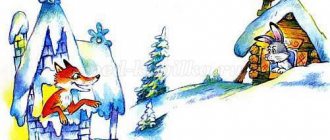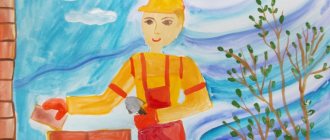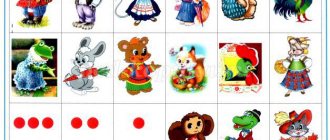Spiritual and moral education of preschool children through the perception of Russian folk tales
Popova Lyudmila Viktorovna
Spiritual and moral education of preschool children through the perception of Russian folk tales
A fairy tale enters a child’s life from a very early age, accompanies him throughout preschool childhood and remains with him for life. His acquaintance with the world of literature, with the world of human relationships and with the entire surrounding world in general begins with a fairy tale
Fairy tales present children with a poetic and multifaceted image of their heroes, while leaving room for imagination. Moral concepts, vividly represented in the images of heroes, are reinforced in real life and relationships with loved ones, turning into moral standards that regulate the desires and actions of the child.
Introducing children to reading fairy tales and traditional Russian culture contributes to the harmonious formation of a human personality capable of realizing its historical affiliation with its native people . Folk traditions are necessary for the comprehensive development of a child, the formation of patriotic feelings, spiritual and moral qualities , and the development of creative potential. By introducing children to folk culture , we help children enter the world of beauty, mystery, the world of adventures, experiences and emotional pleasure, and give them the opportunity to be proud of the achievements of their ancestors. Folk art contributes to a profound impact on a child’s world, has moral, aesthetic, and educational value, and embodies the historical experience of many generations.
It is in childhood that a child develops his first ideas about himself and develops moral and social norms. In other words, in the process of socialization, a child must be taught norms and rules of behavior, emotional responses to various situations, ways of expressing and experiencing various feelings. The child gradually learns how to understand the surrounding natural and social world, which is why a fairy tale , which does not give direct instructions “Listen to your parents, respect your elders”
,
“Do not leave home without permission
,” but its content always contains a lesson that they gradually
perceive , repeatedly returning to the text of the fairy tale . A simple fairy tale contains everything you need, the most important thing in life, alive like life itself.
In order to ensure effective, targeted and systematic interaction with children on moral education , we have developed long-term and calendar plans. Planning was carried out in accordance with the age characteristics of the children; we selected the content, methods, techniques and forms of work in accordance with the assigned tasks, and provided for a gradual complication of the content of the work, taking into account the achievements of the children.
When determining the means and methods of influence on children, we were guided by the principle of being demanding of the child combined with respect for his personality. This principle found its pedagogical embodiment in the system of A. S. Makarenko. The application of this principle in practice is expressed in the teacher’s to combine kindness with reasonable demands, taking into account the capabilities, development, moral experience and individual characteristics of children. This makes it possible to form in children the foundations of moral behavior and discipline, without suppressing initiative and cheerfulness, and to teach them to respect the order established in the group. The teacher, in turn , is required to have restraint, patience, reasonable rigor, and respectful attitude towards students .
The principle of unity of influences on feelings, consciousness and behavior follows from the concept of the integrity of the process of personal development. It requires an integrated approach when choosing means and methods of moral education . When determining the content of educational influence , we took into account whether it would evoke an emotional response in the child, whether it would be understood, and whether it would form certain ideas about the phenomena of the surrounding life.
When planning the work, we used the principle of systematicity and consistency, which consistently complicates the tasks of education for the entire group as a whole and for each child individually (taking into account his characteristics and the level of assimilation of the introduced moral rules and behavioral experience).
In working with children, we used fairy tales recommended for reading, ethical conversations, theatrical games based on fairy tales , and problem situations.
By middle preschool age, children's range of ideas about the world, themselves and the people around them expands. perceive fiction are also expanding Children are able to emotionally and holistically perceive a text , identify characters and individual episodes, establish cause-and-effect relationships, and evaluate the characters’ actions.
For reading to children, we selected fairy tales that contribute to the development of moral qualities, help determine the negative and positive actions of the characters, and contain a “moral lesson”
(see Table 1)
.
Fiction used for reading to children
Fairy tale title
"The wolf and the seven Young goats"
,
“Zayushkina’s hut”
Victory of good over evil
"Swan geese"
,
“Sister Alyonushka and brother Ivanushka”
,
“Masha and the Bear”
Source
MAGAZINE Preschooler.RF
Fairy tale as a means of spiritual and moral education of preschool children “A fairy tale is a seed from which an emotional assessment of life phenomena grows.” Spiritual and moral education is the formation of a value-based attitude to life that ensures sustainable, harmonious development of a person, including the cultivation of a sense of duty, justice, responsibility and other qualities that can give high meaning to a person’s deeds and thoughts. Any society is interested in preserving and transmitting accumulated experience, otherwise not only its development, but also its very existence is impossible. The preservation of this experience largely depends on the system of upbringing and education, which, in turn, is formed taking into account the peculiarities of the worldview and socio-cultural development of a given society. The spiritual and moral formation of the new generation, the preparation of children and youth for independent life is the most important condition for the development of Russia. The problem of spiritual and moral education in the conditions of modern Russian society has acquired particular importance in recent years. This is primarily due to its profound changes, which gradually led to the awareness of the scientific, pedagogical community and relevant government services of the need for a radical revision not so much of the content, forms and methods of education, but of the existing means and methods of spiritual and moral education of the younger generation throughout the educational space of Russia . The decline in the cultural and intellectual level of the nation requires the revival of the traditional spiritual and moral hierarchy of values. Sharply increased property differentiation and the struggle for an elementary level of existence created the preconditions for the spontaneous formation of mores based on selfishness, pragmatism and individualism. The loss of moral guidelines, the devaluation of such categories as Conscience, Honor, and Duty led to negative consequences in society: social orphanhood, increased crime among adolescents, vagrancy, substance abuse and drug addiction among minors, loss of interest in learning and self-improvement among a large layer of asocial youth, as well as parental irresponsibility and indifference to the upbringing of the younger generation, not only among parents from difficult families, but also among those who are busy with their careers and have neither the time nor the desire to devote their energy to raising their own children. It is precisely lack of spirituality that underlies such negative phenomena in our society. Society is beginning to clearly understand that spirituality and morality are inextricably linked with social responsibility, which cannot be established without the means to ensure the spiritual and moral development of a person. At the same time, a worthy spiritual and moral position of an individual cannot be selective, limited to one or several spheres, it must manifest itself always and everywhere. In other words, it is impossible to talk about the problems and tasks of educating spirituality and morality as a mass phenomenon without regard to the specific social conditions that have developed in society. The development of new technologies for spiritual and moral education will help give a new impetus towards the much-desired changes and consolidate them in society as quickly as possible. In this series, a truly innovative technology is the technology of spiritual and moral education of children of preschool and primary school age, with integrated issues of content, forms, means and methods of using the author's didactic fairy tale as a methodological means of comprehensive education of children, systematically revealing the role of the teacher, family, specific parent and society (with all the phenomena included here) in the complex and long process of spiritual and moral development of the child’s personality. It is well known that the age from three to six is the age of why. Today, many scientists and pedagogical practitioners are of the opinion that if children are taught to read before this age, they will read in books the answers to the questions that interest them and will not learn to ask them. In a child who learns to read before thinking, his thinking becomes formalized. He will absorb ready-made information from books, not knowledge. In our time, in the pursuit of intellectual development, the education of the soul, the moral and spiritual development of the child is missed, without which all accumulated knowledge may be useless. In preschool age, a sense of patriotism begins to form: love and affection for the Motherland. Devotion to her, responsibility for her, the desire to work for her good, to protect and increase wealth. The spiritual and moral education of preschool children includes the transfer of knowledge to them, the formation of attitudes based on it, and the organization of age-appropriate activities. The central idea of nurturing love for the fatherland among Russian teachers was the idea of nationality. So, K.D. Ushinsky Fr. It was he who introduced the term “folk pedagogy”, combining folklore as a brilliant means of revealing national identity and forming patriotic feelings. V.A. Sukhomlinsky argued that childhood is an everyday discovery of the world and therefore it is necessary to make sure that it becomes, first of all, a knowledge of man and the Fatherland, their beauty and greatness. Solving the problems of moral education requires finding the most effective ways or rethinking the already known ones. An effective means of educating the moral qualities of preschoolers is a fairy tale. There are fairy tales in every home. During the preschool period, they are read to children of all ages, and children love them. In our kindergarten, we introduce children to fairy tales, in addition to all of our favorite and well-known cartoons, by listening to audio books: Russian fairy tales (Ryaba Hen, Kolobok, Turnip, Teremok, Three Bears), Russian fairy tales 2 (Tar Bull, The Wolf and the Seven Little Kids, Masha and the Bear, Cat and Fox) etc. Russian folk tales (Alyonushka and Brother Ivanushka, Ivan Tsarevich and the Gray Wolf, The Frog Princess, Tiny Khavroshechka, Gray Neck, Two Frosts), etc. We also conduct many different events with the help of presentations (KVN “Guess the Fairy Tale” for preparatory groups, “What a delight these fairy tales are” quiz for the little ones, Introduction to fiction for older groups, “Acquaintance with the fairy tales of A.S. Pushkin, etc. .d. puppet theater. From them they draw a lot of knowledge: the first ideas about time and space, about the connection of man with nature, with the objective world. A fairy tale allows a child to experience courage and perseverance for the first time, to see good and evil. Russian pedagogy for more than a hundred years ago spoke about fairy tales not only as educational and educational material, but also as a pedagogical means, method. Fairy tales represent rich material for the moral education of children. It is not for nothing that they form part of the texts in which children comprehend the diversity of the world. The great Russian teacher K.D. Ushinsky had such a high opinion of fairy tales that he included them in his pedagogical system, believing that the simplicity and spontaneity of folk art corresponded to the same properties of child psychology. Ushinsky developed in detail the question of the pedagogical significance of fairy tales and their psychological impact on the child. V.A. theoretically substantiated and confirmed by practice that a fairy tale “is inseparable from beauty, contributes to the development of aesthetic feelings, without which nobility of the soul, heartfelt sensitivity to human misfortune, grief, and suffering are unthinkable. Thanks to a fairy tale, a child learns about the world not only with his mind, but also with his heart.” In his opinion, a fairy tale is a fertile and irreplaceable source of instilling love for the Motherland. From time immemorial, it was the fairy tale (following the lullaby and the affectionate pestle) that introduced children into the world of ideals and values of traditional culture. A child, a six-year-old, and even a teenager needs a fairy tale. Only the tasks of the fairy tale in relation to each age are different. If a fairy tale comforts and occupies the smallest child, then a fairy tale truly educates older preschoolers and younger schoolchildren. And it can help a teenager understand completely unimaginable problems, reflect on the moral laws of life and find hope. G.N. Volkov, analyzing the role of fairy tales in the formation of a child’s personality, concludes “that the spiritual charge accumulated by the people over thousands of years can serve humanity for a long time. Moreover, it will constantly increase and become even more powerful. This is the immortality of humanity. This is the eternity of education, symbolizing the eternity of humanity’s movement towards its spiritual and moral progress.”| Next > |
Consultation for parents “The role of fairy tales in the moral and aesthetic education of preschool children.”
In order to talk about various genres of works of oral folk art separately, it is necessary to reveal the influence of fairy tales on the development of preschool children, especially with regard to moral and aesthetic development.
View the contents of the document “Consultation for parents “The role of fairy tales in the moral and aesthetic education of preschool children.”.”
Consultation for parents “The role of fairy tales in the moral and aesthetic education of preschool children.”
A fairy tale is a lie, but there is a hint in it, a lesson for good fellows.
Considering the significance of various genres of works of oral folk art separately, one cannot help but reveal the influence of fairy tales on the development of preschool children, especially with regard to moral and aesthetic development.
Preschool age is the most sensitive of all age periods; it is at this time that the foundations of the human personality, its moral and cultural values are laid.
For thousands of years a fairy tale
opened and opens the way to the world for the child.
Having barely begun to become aware of himself, the child comprehends his surroundings, assimilates the laws of communication, and establishes the difference between “good”
and
“bad”
precisely through
a fairy tale
.
The word "fairy tale" first appears in the seventeenth century as a term denoting those types of oral prose that are primarily characterized by poetic fiction. Until the mid-nineteenth century, fairy tales were seen as “just fun”, worthy of the lower classes or children, so fairy tales published for the general public at that time were often reworked and rewritten according to the tastes of the publishers.
A fairy tale introduces a child to some imaginary circumstances and forces him to experience, together with the characters, feelings that influence his entire subsequent life. From the very beginning of the fairy tale, the child takes the position of a positive hero and solves the assigned problems together with him. All this stimulates the creative activity of a preschooler and forces him to draw conclusions that are inaccessible to him in other circumstances. Due to the fact that the child enters into the depicted circumstances, mentally takes part in the actions of the characters, experiences their joys and sorrows. Fairy tales contain rules for people to communicate with each other, rules for politely addressing each other, statements, requests, signs of respect for elders (“bowed to the waist”, “you should have fed me first, given me something to drink, steamed me in a bathhouse”).
The fairy tale would not be a fairy tale if it allowed the villain to triumph over innocently persecuted people. This kind of ending is common in fairy tales. There are no such troubles that the heroes of fairy tales do not fall into, but there are also no such troubles that they would not avert from themselves. Good wins, justice prevails. Of course, such an ending to stories, like many things in a fairy tale, is fiction, but fiction is not aimless. The storytellers did not put up with the evil of life, they dreamed of a just life.
It is known that many fairy tales begin with the beginning: “Once upon a time they lived,” and end with the sentence: “They began to live, live well and make good.” And telling fairy tales itself presupposes knowledge of special formulas, like this: “Soon the fairy tale is told, but not soon the deed is done.”
Fairy tales teach children not to submit to evil treatment, not to give up when problems arise, but to bravely fight troubles and overcome them, to win not only with physical strength.
As a rule, children rejoice at the hero’s successes and hate the bad things that the heroes struggle with. A fairy tale often has an advantage over other educational techniques.
The Russian folk tale contains rich content in terms of the saturation of artistic speech with linguistic means of expressiveness (comparisons, epithets, synonyms, etc.), for example: the beautiful maiden; clear falcon; a horse is a wolf's fill; grass bag; stand in front of me like a leaf in front of the grass, etc., which children use in their own speech, which contributes not only to the development of its imagery, its enrichment, but also to the development of the creativity of preschoolers themselves. Mastering such formulas helps the child create, remake, or even completely create fairy tales.
He develops a sense of proportion and a sense of the line that imagination in art should not cross, and at the same time, he begins to develop realistic criteria for aesthetic assessments. A fairy tale plays a vital role in the development of imagination - an ability without which neither the mental activity of a child during school, nor any creative activity of an adult is possible.
The fairy tale is a work of folk art and carries a rich spiritual charge. Emphasizing this potential possibility of a fairy tale, the outstanding thinker I.A. Ilyin writes: “A fairy tale is already art: for it conceals and reveals behind words a whole world of images, and behind the images it understands artistically and symbolically a deeply spiritual state.”
All this points to the great potential of fairy tales in the moral and aesthetic education of preschool children.
Thus, with the correct selection of fairy tales, taking into account the age characteristics of children, the ideological and artistic value of the work and the correct organization of the subsequent activities of children, fairy tales can have a huge educational impact on the child.
Source



